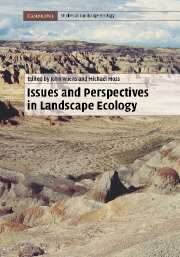Book contents
- Frontmatter
- Contents
- List of contributors
- Preface
- PART I Introductory perspectives
- PART II Theory, experiments, and models in landscape ecology
- PART III Landscape patterns
- 11 Landscape pattern: context and process
- 12 The gradient concept of landscape structure
- 13 Perspectives on the use of land-cover data for ecological investigations
- PART IV Landscape dynamics on multiple scales
- PART V Applications of landscape ecology
- PART VI Cultural perspectives and landscape planning
- PART VII Retrospect and prospect
- Index
- Plate section
- References
11 - Landscape pattern: context and process
from PART III - Landscape patterns
Published online by Cambridge University Press: 20 November 2009
- Frontmatter
- Contents
- List of contributors
- Preface
- PART I Introductory perspectives
- PART II Theory, experiments, and models in landscape ecology
- PART III Landscape patterns
- 11 Landscape pattern: context and process
- 12 The gradient concept of landscape structure
- 13 Perspectives on the use of land-cover data for ecological investigations
- PART IV Landscape dynamics on multiple scales
- PART V Applications of landscape ecology
- PART VI Cultural perspectives and landscape planning
- PART VII Retrospect and prospect
- Index
- Plate section
- References
Summary
The analysis of pattern is a fundamental part of landscape ecology. Typically, we view landscape as a mosaic of elements and believe that their spatial arrangement controls or affects the ecological processes that operate within it. Similarly, we claim that landscape pattern itself is generated by other processes operating across such mosaics. As a scientific community, we face the problem that, while we agree about the importance of pattern, we have few theoretical generalizations to help those interested in the conservation or management of landscape resources (Wu and Hobbs, 2000). Much contemporary work on pattern has focused on the analysis or description of spatial geometry and has failed to provide any understanding of the significance or meaning of those patterns. This tendency has been exacerbated by the availability of digital landscape data and GIS algorithms that allow us to rapidly calculate a whole range of landscape metrics.
Some would dispute the claim that landscape ecology has provided few empirical generalizations about pattern. I feel able to make this claim because I too have been tempted down the road of analyzing landscape pattern using the computer-based technologies now widely available (e.g., Haines-Young and Chopping, 1996). My present unease comes from the observation that, while we have had some success in persuading the policy community that landscape ecology should be taken seriously, we have been unable to give much advice about the sensitivity of ecological systems to changes in the structure and composition of landscape mosaics (Opdam, et al., 2001).
- Type
- Chapter
- Information
- Issues and Perspectives in Landscape Ecology , pp. 103 - 111Publisher: Cambridge University PressPrint publication year: 2005
References
- 7
- Cited by

